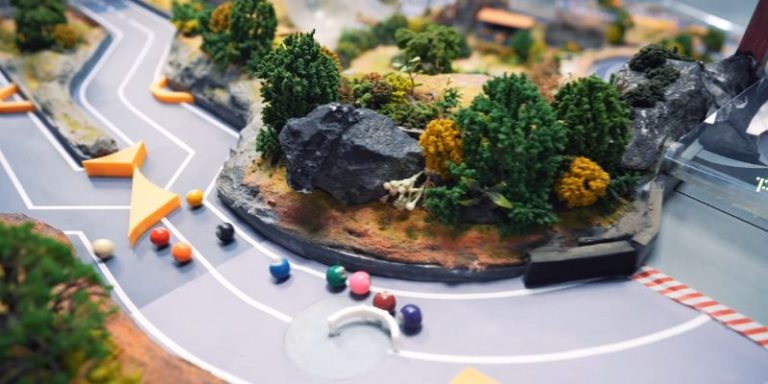Official marble racing rules: How competitions stay fair
Marble racing is more than just rolling marbles down a track; it’s a structured competition with formal rules to ensure fairness and excitement. Leagues such as Marble Magic and Jelle’s Marble Runs adhere to precise starting procedures, track standards, and scoring systems, ensuring that races are competitive and consistent.
These regulations level the playing field, prevent undue advantages, and keep each race exciting and surprising for fans and racers. Let’s look at the formal rules that keep marble racing fair.

Standard race formats in marble racing
In marble racing, many race formats incorporate strategy, excitement, and unpredictability. The following are the most prevalent formats used in official competitions:
- Time Trials – Each marble competes independently against the clock, with the fastest time choosing the winner. Precision and quickness are critical.
- Head-to-Head Races – Marbles race on the same course, competing for position and speed as they approach the finish line.
- Elimination Races – In each round, the slowest marble is removed, leaving only one champion. Every second matters!
- Team-Based Leagues—Rather than individual races, marble teams collect points for numerous events, resulting in intense and season-long rivalries.
Each format requires different skills, making marble racing more than just a game of chance—it’s a fast-paced sport, and each race is unique!
Key rules that keep the races fair
Competitive marble racing adheres to stringent standards that ensure each race is fair, thrilling, and skill-based. Here are the key rules that preserve balance and consistency in formal tournaments.

- Starting Mechanism – Races begin with automatic mechanical gates that ensure all marbles launch simultaneously without human intervention. This discourages early starts and ensures that all races are fair.
- Track Design & Regulation – Tracks are meticulously created with standardized curves, ramps, and obstacles to assess talent without favoring any particular stone. The layout must allow for easy rolling while also incorporating rigid components.
- Marble Specifications—Official races govern size, weight, and substance to prevent unfair advantages. Ceramic and glass marbles are often used, although enormous or exceptionally heavy marbles are prohibited.
- Race Timing and Scoring: Competitions use high-precision timers, sensors, and manual.
These criteria ensure that all competitors have an equal chance of winning, making marble racing a legitimate and unexpected sport!
Penalties and race infractions
Like other traditional sports, Marble racing has penalties and infractions to ensure fairness and integrity. Breaking the regulations might result in restarts, disqualifications, or even a ban from competition. Here are the major offenses that officials watch during races.
False Starts
A good start is essential in marble racing. The race is resumed if a marble moves before the official release mechanism engages. To guarantee competitive fairness in leagues such as Marble Magic and Jelle’s Marble Runs, several false starts by the same participant may result in penalties or disqualification.
Track Interference
Races must be free of extraneous disturbances. Any outside force, such as inadvertent track contact, purposeful interference, or environmental conditions like wind, can invalidate or restart a race. The contender may be disqualified if interference offers a marble an unfair advantage.

Marble Damage or Tampering
Marbles used in formal competitions must adhere to specific size, weight, and material requirements. Any modifications, such as increasing weight, applying coatings, or changing the surface texture for an advantage, are prohibited. If a stone is discovered to be tampered with, it may be banned and the racer disqualified.
By adhering to these principles, marble racing remains a fair and thrilling sport, with triumphs achieved via skill, strategy, and track flexibility rather than unfair advantages.
How marble racing leagues enforce rules
Organized leagues enforce tight rule sets to keep marble racing fair and competitive. Every safeguard, from race officials to video replays, ensures that each competition is fair and transparent.
Race Officials & Monitoring
Professional marble racing leagues like Marble Magic and Jelle’s Marble Runs have race officials who monitor events. They track false starts, interference, and rule infractions to ensure a level playing field. If an issue emerges, officials may call for a restart or disqualification.
Video Replays & Fan Engagement
Slow-motion replays ensure accuracy when reviewing close finishes and disputed calls. Some leagues even allow fans to review race judgments, promoting openness and community engagement. This strategy makes marble racing more engaging and trustworthy for viewers.
Evolving Rules for Fair Competition
As marble racing becomes more popular, leagues work to modify and update laws to ensure fairness. Adjustments to track standards, marble specs, and timing technology help to ensure competitive integrity while keeping the sport exciting.
With these safeguards, marble racing remains a legal, exciting, and skill-based sport. Each race is fair, unpredictable, and action-packed!
Why fairness matters in competitive marble racing
Fair play is the cornerstone of competitive marble racing. Without tight rules and restrictions, races would be based solely on luck, making competitions less thrilling and meaningful. Here’s why fairness is critical to the sport’s success.
Skill Over Luck
Fair regulations ensure that race results are determined by speed, momentum, and track adaptability rather than random chance. Standardized circuit designs, marble specs, and race formats allow the finest racers to shine through strategy and precision, ensuring that each victory is hard-earned.
Engaging & Trustworthy Competitions
Fans desire genuine competition, with marbles winning based on performance rather than undue advantages. Precise results, reliable timing systems, and stringent rule enforcement keep races entertaining and unpredictable while preserving public trust in the sport.
A Growing & Credible Sport

Leagues such as Marble Magic and Jelle’s Marble Runs have helped establish a professional racing scene by ensuring that each race is fair. This credibility attracts more fans, sponsors, and players, allowing marble racing to become recognized worldwide.
Fairness is more than a guideline; it makes marble racing competitive, exhilarating, and enjoyable to watch!
Getting involved in marble racing competitions
Joining the marble racing community has never been easier, whether you want to watch, compete, or organize your events. Significant leagues, such as Marble Magic and Jelle’s Marble Runs, regularly stream races on YouTube, Twitch, and their official websites, providing high-speed action to fans worldwide.
Joining online groups is a terrific opportunity to connect with other enthusiasts who want to do more than watch. Platforms like Reddit, Discord, and Facebook groups enable fans to discuss racing strategies, post predictions, and even engage in community-driven leagues.
If you want to take things to the next level, organizing your marble races might be an exciting experience. Designing a DIY track with fair regulations, consistent scoring, and thrilling obstacles adds a new layer of competition. Whether a friendly race with friends or a full-fledged tournament, ensuring fair play and exciting race formats for all participants is essential.
From spectator to competitor, anyone can participate in marble racing—all you need is a track, some marbles, and a sense of adventure to get started!
FAQ about marble racing rules
Who enforces the rules in marble racing leagues?
Race officials monitor the races, aided by cameras and sensors for accurate enforcement.
Are false starts penalized in marble racing?
Yes. Races with early starts are restarted, and repeated violations can lead to disqualification.







One Comment